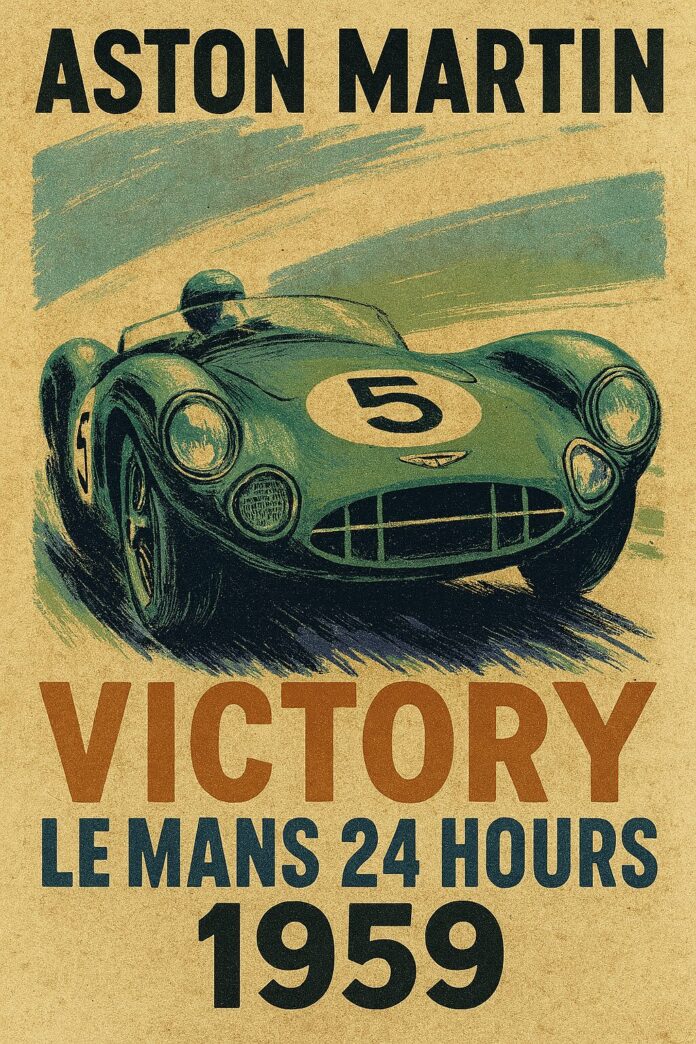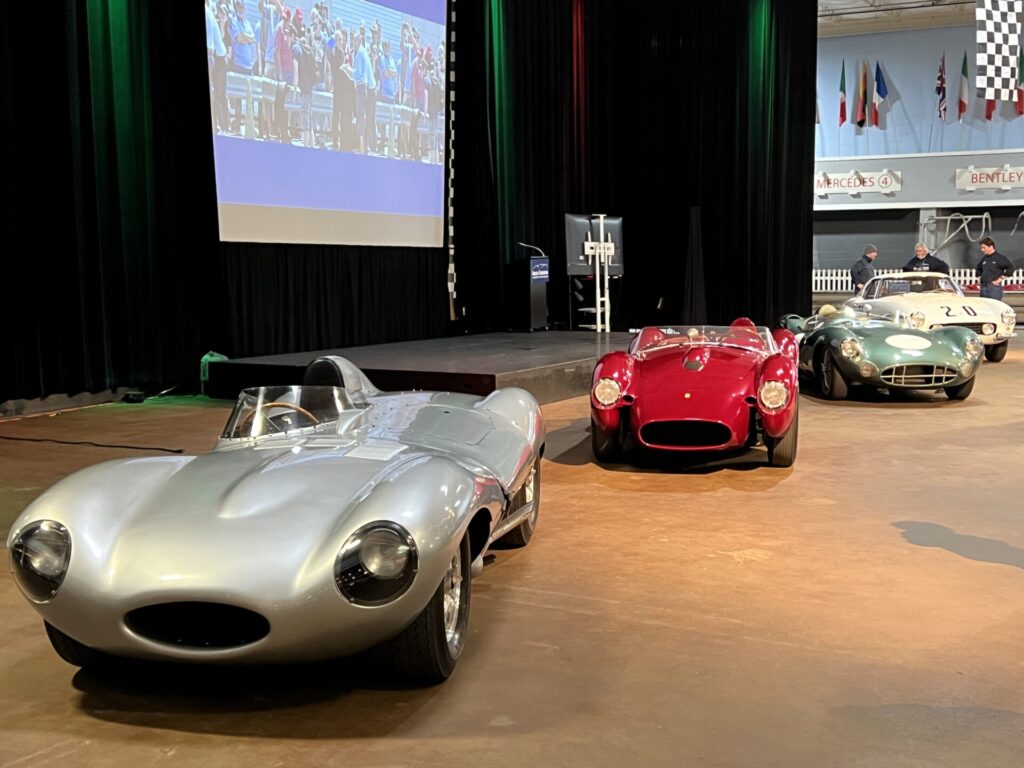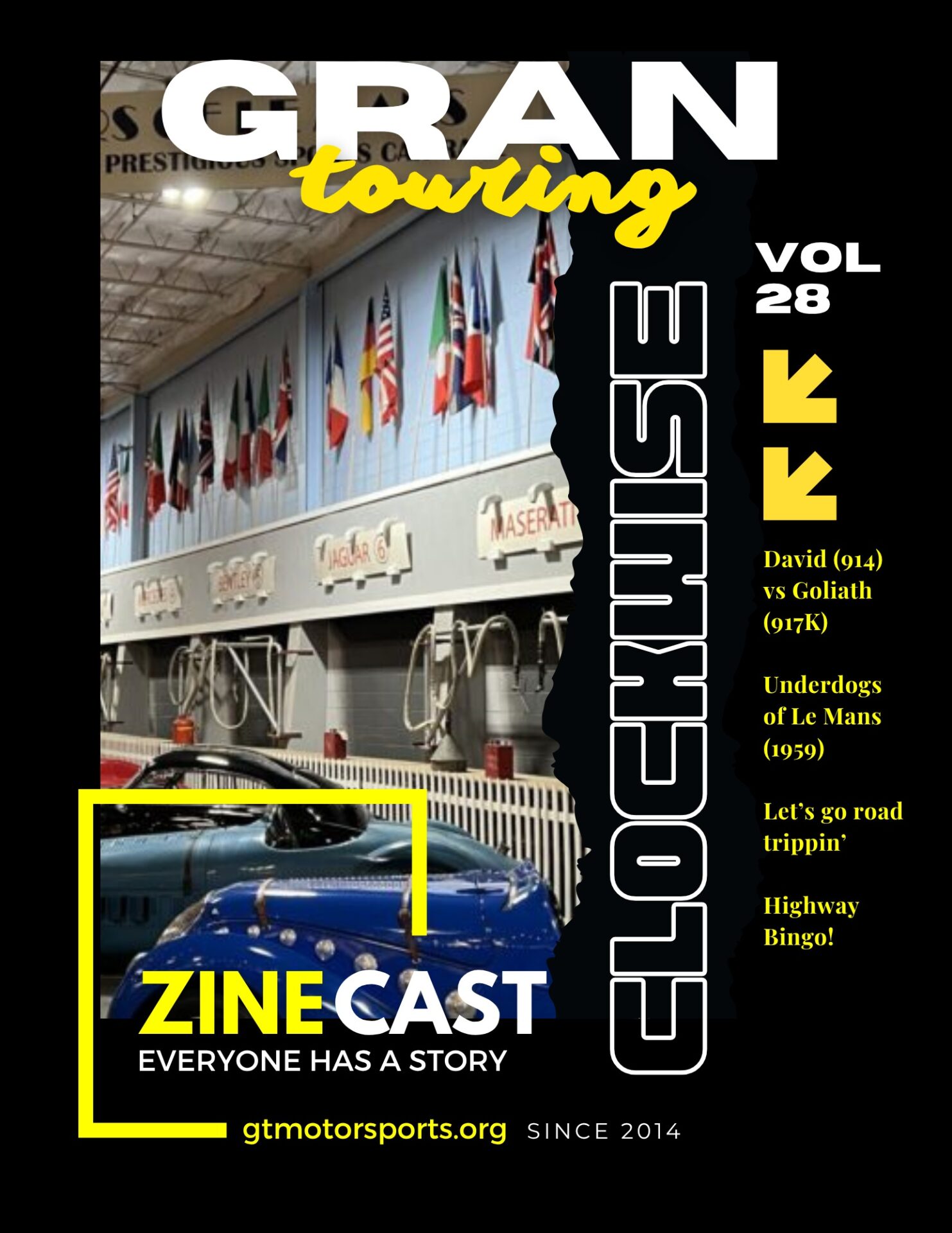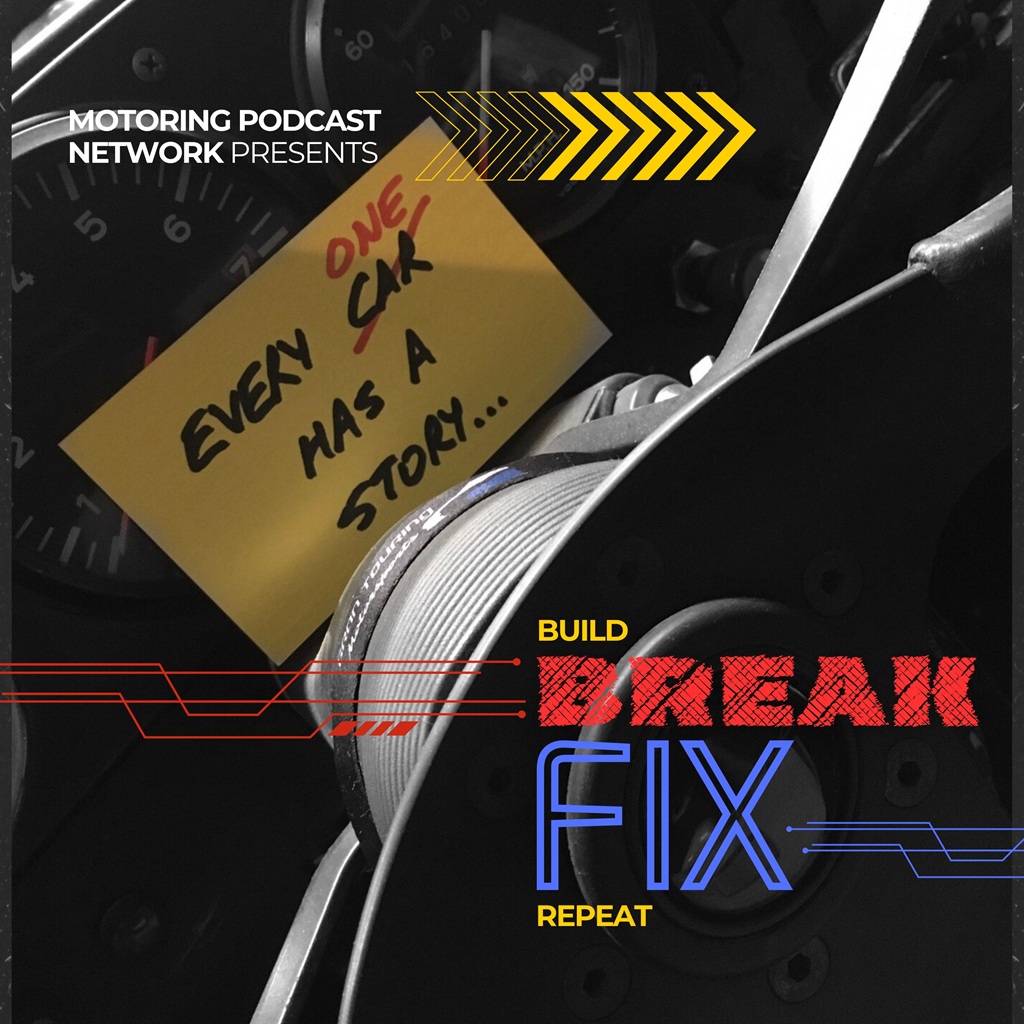At the Simeone Museum in Philadelphia, history roared to life during a special demo day honoring one of motorsport’s most improbable triumphs: Aston Martin’s stunning victory at the 1959 24 Hours of Le Mans. In a world dominated by racing giants like Ferrari and Jaguar, this modest British team defied the odds and etched their name into endurance racing legend.
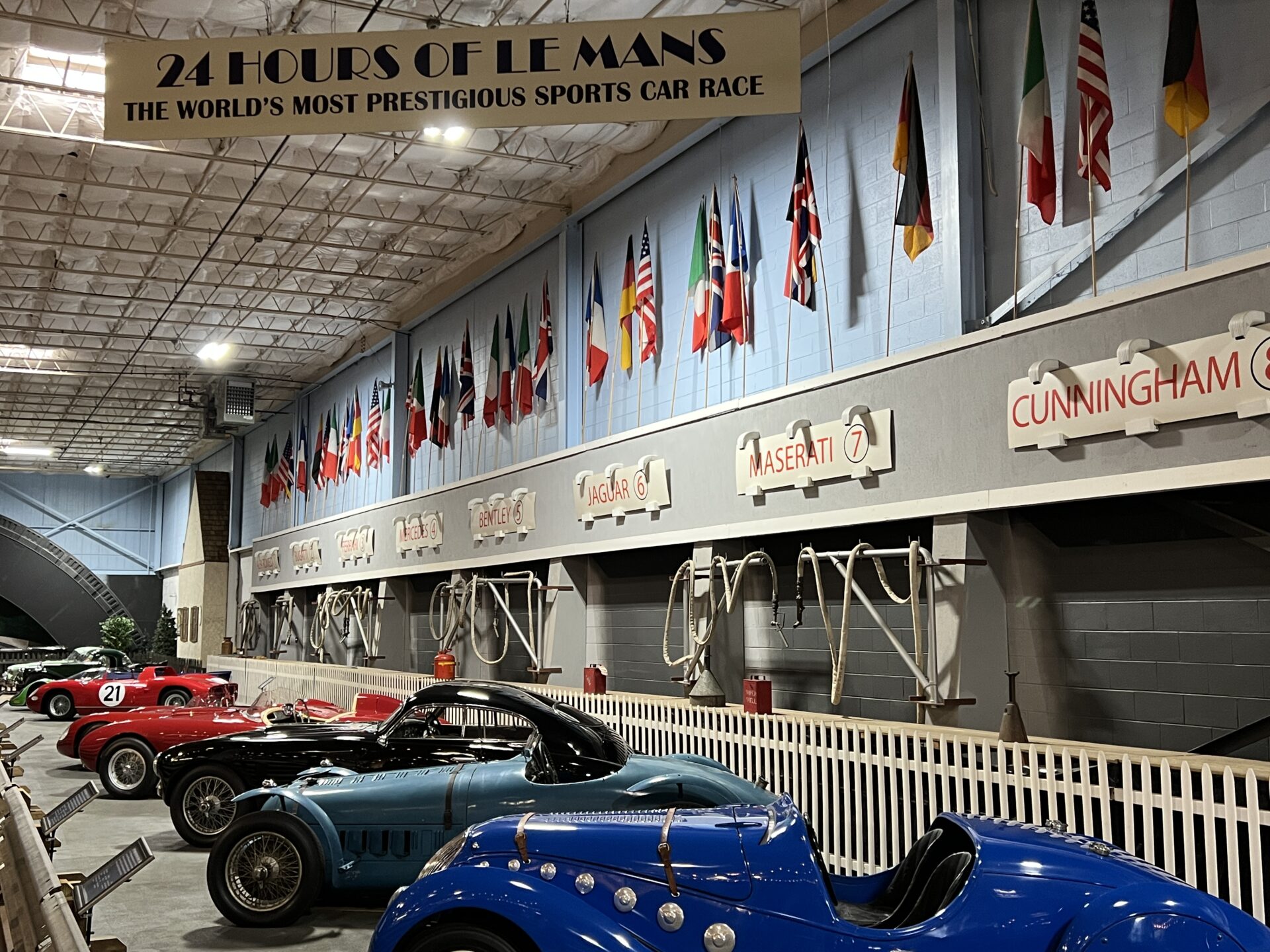
Le Mans isn’t just a race – it’s a proving ground. As Dr. Simeone often said, winning Le Mans is like winning the Super Bowl. It’s the kind of victory that sells cars, cements legacies, and turns drivers into icons. In the 1950s, Jaguar knew this well. Bill Lyons didn’t chase championships – he chased Le Mans wins. And he got them.
Tune in everywhere you stream, download or listen!
 |  |  |
Visitors to the museum were treated to a rare sight: three of the most iconic sports cars of the era, each with its own story and engineering marvels.
1956 Jaguar D-Type (above; left)
- Cast iron inline-six, twin overhead cams, originally 3.5L (reduced to 3.0L post-1955 tragedy)
- Monocoque construction by aircraft designer Malcolm Sayer
- Four-wheel disc brakes—a revolutionary advantage over Ferrari’s drums
- Dry sump oil system for lower engine placement and better aerodynamics
- Passenger car engine roots, proving you didn’t need exotic tech to win
1958 Ferrari 250 Testarossa (above; center)
- V12 thoroughbred with downdraft Webers and outboard spark plugs
- Drum brakes, still reliable despite Jaguar’s disc innovation
- Tubular frame with hints of space frame geometry
- A symphony of engineering and sound, built for speed and endurance
- 1958 Aston Martin DBR1
- Alloy body so light it dents with a fingertip
- True space frame chassis for strength and weight savings
- Inline-six, 3.0L, 250 hp with a five-speed gearbox
- Aircraft-inspired cockpit and layout
- The car that would carry Carroll Shelby and Roy Salvadori to victory
1958 Aston Martin DBR1 (above; right)
- Alloy body so light it dents with a fingertip
- True space frame chassis for strength and weight savings
- Inline-six, 3.0L, 250 hp with a five-speed gearbox
- Aircraft-inspired cockpit and layout
- The car that would carry Carroll Shelby and Roy Salvadori to victory
- Synopsis
- Transcript
- Bonus Content
- Learn More
Synopsis
This live episode of Break/Fix discusses the 1959 Le Mans victory of Aston Martin, an underdog team, at the Simeone Museum demo day event. The event highlighted Aston Martin’s unexpected triumph against larger, well-funded teams like Ferrari and Jaguar. Key discussions include an in-depth look at the featured cars, such as the 1956 Jaguar D Type, 1958 Aston Martin DBR1, and 1958 Ferrari 250 Testarossa, as well as the competition and challenges faced during Le Mans races. The narrative details the meticulous planning and teamwork of Aston Martin and the driving expertise of Roy Salvadori and Carroll Shelby, leading to their remarkable win despite numerous challenges. The episode also covers the broader historical context of racing, the technical specifications of the cars, and the personalities involved in the 1959 race.
- Footage and Photos were taken during the 2023 Demo Day leading up to the 100th Anniversary of LeMans on-site at the Simeone Foundation/Museum by the GTM/MPN crew.
Transcript
[00:00:00] Brake Fix Podcast is all about capturing the living history of people from all over the autosphere, from wrench turners and racers to artists, authors, designers, and everything in between. Our goal is to inspire a new generation of petrolheads that wonder, how did they get that job or become that person?
The road to success is paved by all of us, because everyone has a story.
Le Mans 1959 The Underdog Champion. The Simeone Museum in Philadelphia, Pennsylvania is proud to present Le Mans 1959 The Underdog Champion, a demo day event celebrating the unlikely and impressive victory by a relatively small and underfunded Aston Martin team. At the time, the 24 hours of Le Mans was dominated by larger, highly financed organizations such as Ferrari and Jaguar, who had access to more advanced technology and greater resources.
Despite this, Aston Martin managed to pull off a stunning [00:01:00] upset victory at the 1959 race with their DBR1 piloted by drivers Roy Salvadori and Carroll Shelby. During this demo day, visitors had the chance to see three of the most popular cars in the museum in action, learn from the team of experts about their design and engineering, and discover more about the intense competition and challenges of Le Mans during the late 1950s.
The featured exhibition included cars like the 1956 Jaguar D Type, 1958 Aston Martin DBR1, and the 1958 Ferrari 250 Testarossa. All car racing in the world, you could argue Le Mans is the biggest race in the world. Indy 500, that could be a challenge, but Le Mans, it’s right at the top and it’s certainly beyond any other sports car race, even though there are tremendous sports car races.
The Mille Miglia is the first one that comes to mind, a thousand miles on public roads in Italy. But Le Mans. If you won, as Dr. Simeon liked to say, it was like winning the Super Bowl. Winning Le Mans, the [00:02:00] drivers names went down in history. Everybody knows, you know, the drivers of these cars. You know the marks.
And that’s why Bill Lyons, all he cared about was winning Le Mans. They didn’t enter many of the other races. They certainly didn’t go after the championship. But they won Le Mans, and they did it consistently in the 1950s, and that sells cars. So, it’s a very big deal to win Le Mans. So, let’s see what we have here with our underdog champion.
Well, our underdog champion, we’re talking about Le Mans 1959. Espin Martin in this case. So, if you’re wearing green today, you’re with the underdog. You’re clearly got it now. Let’s take a quick look at our cars here, and that’s what we call scrutineering. It’s just a little technical look at, at our metal of the day.
Start with, uh, the Edward D Type. Exciting, wonderful car, favorite of many of ours. Cast iron block, six cylinder, in line, twin over cam, three and a half liters. However, after the 1955 Le Mans, tremendous accident, and 80 people killed, the, uh, [00:03:00] organizers reduced displacement down to three liters. They changed, you know, the rules.
Sir, 1956 and in fact 1956 Lama wasn’t even on the sports card championship count where Lama was a race if he won on the sports card for the championship account for double points. So here’s in 56, not even on the count, it was still a race, but not on the sports card championship. four speed gearbox. Of course, it’s a monster gearbox.
Not four wheel independent suspension. It’s a live axle in the back. Keep in mind that this car is built for Le Mans. They almost didn’t enter other things. They never went after the championship. They were after Le Mans. Winning the championship is great. Ferrari was the master of it, but if you just won Le Mans, you took all the press.
You, the win, right out of the sails of the champion, the Le Mans winner got it. The news of the Le Mans winner sold cars. So, Bill Lyons from Jaguar, he was after Le Mans, not much else. And the cars were both for Le Mans. Alloy body. And of course, that’s important thing about this body. [00:04:00] It’s monocoque, the tubular chassis in these cars.
And over there, we actually have a monocoque. So that’s big news in a sports car. Remember Mercedes in the early 50s, and they’re giving us space frame. and fuel injection, and full independent, and some pretty hot stuff, and you can buy that in a road car, 300SL. But going to a monocoque is really, that’s jumping into the future.
Malcolm Sayre, he’s an aircraft designer out of World War II, comes on with Jaguar, and he’s not just going aerodynamic, but he’s going aeronautic, airplane technology, with that kind of construction, light, rigid, strong. 350 horsepower, that sounds high, I think it’s more like 270, 280. As we moved along, they start out around 250.
As we travel along and we get, we have three Webers, you know, the CJAG starts with two Webers. Ultimately, fuel injected, the Lucas fuel injection, they’re snickering how it’s going up and up all the time, and on the RD Jaguars. Tension independent front [00:05:00] of course, by ARH, we see it’s rack and pinion, you see the bellows on the steering rack.
But the big news there that you’re looking at is the disc brake. Four wheel disc brakes, Jaguar of course, M51 at Le Mans are running disc brakes. Ferrari. We’re still on drums right up to about 1960. Big news. They’re running the brakes. And what’s the advantage? Well, as you’re running a race and brakes are getting hot as they heat up, brakes are gassing and that actually lessens the contact with the brake to its Yes.
friction surface and braking phase. Some of us are old enough, if you had drum brake American cars, and you raced them around back in the day. Guys with the drum brake cars, they’d be pulling off and saying, I’m done, I have no more brakes. I had an MG. It’s like, what are you guys talking about? I don’t know if brakes went away from you, but guys, we had to stop horsing around.
The brakes were done. So Jaguar on those brakes was a big deal. I think we see the, uh, oiling system. We have an oil cooler. And, the important thing on the D type is we want a low car. Malcolm Sayer is an aerodynamicist. He wants a low [00:06:00] car. Get that engine down low. You can lean it over a little bit. Took the sump off the bottom.
Now we have an oil tank remotely, so we have this dry sumped engine. We’re pumping oil to the engine from a remote tank, getting a lower car. And you’ll even see that the bump on the hood is offset to one side. It’s all about aerodynamics on that car. The rear differential and the body is the center section that is our monocoque and we have a rear section bolted on, a front section bolted on, holding the suspension, holding the engine.
So there’s just added to it when you see the hood up and you see some struts running out, it’s not because it’s a tube chassis, that’s a bolted on attachment to hold the engine and front suspension. And here’s that wonderful engine. And why wonderful? Why do we point out this engine so much? Because it’s a passenger car engine.
Jaguar comes out of this engine in 1949 with twin air brake cam and line six. And it’s just tremendous that you’re racing in Le Mans or winning in Le Mans with basically a passenger car engine. Ferraris is out there killing it. They’re winning the [00:07:00] sports car championship. But that’s a special purpose-built engine that would cost a fortune to put into a passenger car.
You’d have to have a very high, high price car, which of course, Ferraris when you could buy a passenger car. Ferrari, they were very pricey. Jaguars were cheap. You could buy Jaguars for the price of, uh, Corvette and such. So they weren’t like a high priced car. Of course, buying a, a race car like a Ctech or a d defect, that’s different.
But the factory wasn’t gonna sell a URI one of those, they, they went to races. And then moving on to the Testarossa. So, there’s the beauty. Has that body by Scaglietti with the cutaways. And, uh, they only made a few of those. And they went to a more normal looking design. That’s looking for maybe more air flow around the brakes.
Let’s see what our specs are. Well, there we see the drum brakes, as we point out the difference from the D Type, which is already running on four wheel disc, and we’re running on four wheel drum. It, uh, sounds maybe backward, but when you perfect something, and it’s working, and they do work well, the other guy has an advantage, but there’s also a [00:08:00] disadvantage to new technology.
Sometimes it fails, so Ferrari sit back, let them prove it out, let it get developed. They have a well developed drum brake system, and Ferrari sticks with it. So, we have three layers. That’s pretty hot, but Ferrari had attention for the V12. Okay, the board stroke there, 4 speed gearbox, and 300 horse. Really exquisite car, and you love how they sound when you have all those cylinders humming.
Of course, it’s all very lightweight. This is not a passenger car engine. The Ferrari engine is a thoroughbred piece of work. We see the sump down below, all thinned in aluminum for cooling. Up on top, super cool, we have that row of Weber carburetors downdraft and in fact on these cars, they’ve moved the spark plugs outboard so they could have that interesting and efficient carburetor setup.
Now the spark plugs are on the outside with the exhaust manifolds. And we see even the gearbox that’s beautifully made with cooling fins. And, uh, there we see the chassis. So, big news in Monacock and the Jaguar. The Ferrari is on not a space [00:09:00] frame, but a tubular frame. I see a little bit of, uh, stepping towards space frame with the triangulation and such.
A space frame is when all of your, uh, angles are very carefully, uh, Figured out to not have anything but tension on the tubes, you know, have the tube under pressure where it can bend and so on and tension, sometimes maybe compression, and that would be a spaceman. So, moving up to the DVR 1, does it get prettier than that?
Not for a British car. Specs. Alloy body. Super lightweight, uh, with this car, uh, we like to say if you lean on it with your fingertips, you’re gonna have 10 dents in that car. So super lightweight. I love the wheels. We’re on alloy wheels here as we are on the other cars, Jaguars case, uh, alloy disc wheels and then’s here.
Look how light that looks. I think one person could carry that. It’s, uh, all small diameter tubes. And they’re arranged in a way for maximum strength, and that’s when we start calling it the Space Chassis, the Space Frame. [00:10:00] And then, of course, the beautiful lightweight body. So, uh, Tubular Space Frame, where all of our frame is carefully constructed with engineering behind everything, and tubes are in tension during the process.
Pressure or avoiding bending forces on the two, make it stronger and lighter. If you really do things correctly, you can see a tremendous amount of weight and make it stronger or stronger. So a three liter in line, six cylinder, similar to the Jaguar whenever it can, five speed gearbox. In this case, they don’t use it in their brace by that LA off.
That’s a useful thing. You want 250 horsepower. David Brown, of course, is the director and uh, there’s a little. diagram of the cockpit. You look in there, it’s pretty aircraft looking with all the switches and study that. There’s that beautiful engine. Webber carburetors on one side flowing across the cylinder head to go out the exhaust.
Just super lightweight, very rigid and then moving on to the 250 GT Ferrari three liter in 1959. It’s a three liter race for the class. 12 cylinders, three worth of [00:11:00] carburetors, drum brakes, of course, five speed gearbox, and 240 horse pictures here from the brochure. But what do we see in this picture? We see a pretty simple chassis layout.
It’s tube frame, but nothing like a space frame and of course, one full engine V12. That’s kind of our technical look at the cars. We’re looking at some real pure racing machine right here. P type, 250 TR. DBR1 and a, uh, 250 GT. So cars that we love leading up to 1959, Le Mans 24, team managers know this is tough.
The manufacturers tend to know this is tough. Everybody knows it’s tough except Henry Ford. He found out Aston Martin has been going after it. David Brown, who takes over the company. He’s very serious about competition and he wants this Le Mans win. David Brown, he builds tractors and what have you. I think he’s a lot in the mold of Bill Lyons.
He knows. If he can win Le Mans, not only is it a huge boost to your [00:12:00] personal ego and such, but he’s a manufacturing guy. He can turn that maybe in some ways to his advantage commercially as well. They’re running the DB3S. It’s a beautiful car. It looks very much like this, especially when you see them in the Aston Martin green.
It’s a metallic, soft green, that’s Aston Martin green. They get lost on the moor, they’re just not doing it though. They’re doing okay, but they’re not getting the job done. They’re not winning Le Mans, they’re not directing the championship. The DB3 is a wonderful car, but we have Eberhorst’s assistant. He kind of goes around his boss, to John Maher, and suggests that we redesign and come out with a new car, a lighter car.
So, actually the DB3S just doesn’t do it at Le Mans. They go back to the drawing board and come up with a DDR1. That’s Jaguar bragging. That’s what Jaguar puts out after winning Le Mans again. And what they had in 1951, 1953, 55, 6, 7, that’s really doing the job. We have Mercedes [00:13:00] winning in 52, and from the throw from the Jaguars.
End up DNFing, you know, they have oiling problems and overheating problems, and Jaguar takes that win. Ferrari right in the middle there with a win in 1954. Which is also a championship win for them. As we said earlier, Le Mans, you could have double points in the championship from Le Mans. So 1958, we have a car you want to have Jaguar clean it up to the 50s.
Jaguar actually kind of equips the handover cars to teams that are competing at courier costs. Notably, it wins Le Mans with them. Cunning hand team or run the knee Jaguars, but Jaguar is now sitting this out. It’s a very expensive thing. They were in it to accomplish something, which they did at Lamont repeatedly.
Ferrari is in the game for different reasons. He’s just a competitor. Win or lose, Ferrari’s gonna be in the battle forever. Talk about getting outta the battle. One of our heroes, Ian, who has teamed up with Phil Hill, they went in 58. They teamed up again [00:14:00] for 59, even though Ian’s wife. He’s had two dozen acquaintances, friends, co competitors that have died just in his time of racing.
Two dozen, that’s insane. And he has children and the wife wants an acquaintance. But he’s in our game from 1959. Jumping on the tires after four Le Mans wins. Okay, so there we go. Now we’re looking at the championship. Championship is Ferrari’s world. 1953 is when the World Sports Car Championship begins and it’s won by Ferrari.
And they repeat. Breaking 55 with Mercedes. Moss wins the Mille Miglia for Mercedes. The cars are amazing. Technically superior. They win the championship, but after that Le Mans accident, they retire. So Mercedes gets out of the picture and they’re not in a race for 1959. 56th championship. 7th, 8th. It’s Ferrari all day.
They also go on. They win the 62, [00:15:00] 63, 64. Finally in 65, the, uh, Shelby Coupes win. The GT championship in 1965, first time for an American car. That’s another story. Here we have Ferrari coming along to repeat the 1958 win. Of course, hopefully the championship as well. That’s, I would think that’s more important to Ferrari than even the Le Mans win.
But the Le Mans win is important to the championship. So they’re there and they’re serious. So, Phil Hill, Jim Yen, again, our team. And how about Aston Martin? Well, they fall short of a couple of Le Mans, almost, second place. Second place in the championship as well, behind Ferrari, of course. By the way, the cars that are winning the championship Ferrari are like the 375 Mille Miglia, you see it right in TR, these cars win 54.
Who do Aston? We have Reg Parnell as team manager. John Meyers is on board with them. And, uh, they are serious about Le Mans. It’s, uh, an even grand scheme. Reg had, uh, been a driver. He [00:16:00] was with Vanwall before Aston Martin. 1955 Wood Trophy. 1955 Silverstone. Funny thing with him, he went into Formula 1 when Formula 1 was brand new and they had the first Formula 1 race and Parnell’s in it, 1947.
And it’s a, uh, clean sweep for the British. Three ERAs went. ERA, English Racing Automobile. They’re the only three that didn’t even finish. So, clean sweep for the Brits. And their chief rivals, the French, where were they? They’re stranded on a ship, stuck in ice. So that was an easy day. Easy day for the Brits in their first Grand Prix race.
But he’s, uh, team manager of Aston Martin in 1959. John Wyer, uh, we know him much later with, uh, four GTs. The Jaguars. He just had a great career as well. So, 12 hours of Sebring. We have, uh, Ferrari, beginning their championship season with a nice 1 2 finish at Sebring. Keep in mind, when you finish second, finish third, these are more points.
You don’t just get points for finishing first. Having [00:17:00] cars get through the field are very important for a championship. Aston Martin, they did well at Nürburgring. 1, 000 kilometers in Nürburgring, with loss in 59, winning for the second time, and it’s the third time in a row for Aston Martin to win. at the Nuremberg Ring, 1, 000 kilometers.
It’s on the championship calendar. They actually keep in the running by taking this one. 1959, we have Le Mans coming up after Nuremberg Ring. It’s just a few weeks later, of course, Aston Martin is all excited after a win, beating a heavy opposition to go and try to do it again in the big show. One of our heroes, Sterling Moss, on the Aston Martin.
Moss is also driven for Jaguar, he’s driven for Mercedes. Remember, he won the, uh, Mille Miglia for Mercedes in 55. This is typical of the era. Now we’re used to, uh, certain names being attached to certain marks because they race with them so, so long. You know, you can say Schumacher, who, Ferrari, right? These guys, they stay with, with teams.
Now, [00:18:00] Christensen, you only think of one car when you think of our Haman heroes and our champions, but in Moss’s day, these guys bounced around whoever offered them the best deal, the best ride, whatever, excuse me, their desires and whatever deal they could make. So Moss is now he’s with us and Martin is, of course, he’s Really, uh, as a young man, with Jaguar, really showed the way.
So he’s with Jaguar for 51 and 54. Mercedes, Maserati, past the market, goes on the Lotus. And he drove for anybody and anything. He drove every weekend. If you had a Formula 2 race, he’d jump in. If you’re racing saloon cars, he’d jump in. Definitely, we want to say two times winning with Heston Martin and the Newberg rating.
And that’s the third win for Heston. So, Moss is competing also in formula. One of his main competitors, another Brit, might fall for him. You know, it’s all about points. And they’re in a points contested championship race and Hawthorne spins out, he’s facing the wrong way on the course, the [00:19:00] car is stalled, and Moss can’t perform as a competitor, but he’s shouting over to Hawthorne, he’s like, You know, just roll down and bump starter.
And there are various kinds of rules about what you can do out on the track, but Hawthorne, that’s a car, always bumps starts, it’s back in the race, and he’s flagged for this, after the race, there’s a penalty, and Moss defends him about what happened, and Hawthorne gets the points. for whatever he finished in the race.
Hawthorne ends up winning the championship over Moss. Moss had won four races and Hawthorne, I think, had won one. Moss had won plenty more races. But, Hawthorne was ahead by one point and he got the championship. And another part of that story is they’re in the race. And Hawthorne leading, and they, Moss’s pit shows a sign saying what Moss needs to beat him.
Moss needs to set a fastest lap to get Jax for championship points. He misreads the sign, and he doesn’t go for fastest lap. Hawthorne had [00:20:00] the fastest lap. So Moss loses that championship. A championship he never achieved. Of all the great drivers, something like all the great British drivers, he’s the one, the number one in championship that we consider him to be champion.
So there’s Jack Fairman. He’s co driving with Moss in this race, the 59 Camargo. But they’ve co driven together at other events, uh, Durburgring. And Fairman is like Mr. Steady. He’s reliable. He doesn’t get in trouble. In Moss you have the speed, with Fairman you have reliability, and so they make a fine team.
And Moss wins also with him in the tourist trophy. So they team up well together. One thing sometimes is personalities can be a problem in racing. You might have one guy in the car, but you have two guys sharing a car in these endurance races. And personalities can lead to issues. There’s, of course, Carroll Shelby, our own American Texas chicken farmer.
And Lloyd Salvadori teamed up with Shelby. So, uh, Shelby, Salvadori. Racing with Aston. Shelby has a little bit of a thing with Ferrari. [00:21:00] They’ve spoken about Shelby maybe coming on the Ferrari team and there are some issues. Shelby already has a little bit of a drudge. A little chip on his shoulder regarding Ferrari.
But he’s in the car. They’re hoping to compete well. And Roy Salvatore partnered with Shelby. So they’re receiving with a greater cost and less to market. Uh, interesting thing with both of these fellas, they’ve both passed away within, I think, a month of each other. Okay, Maurice and Vincent Young. Also on our teams are, here we have them winning the 54 Tourist Trophy, 55 and 85 Monaco, I don’t know about that, and 1953.
54. He’s at Lamont’s. He’s with all kinds of great outfits. He’s with Maserati, Ferrari, Martin, Porsche has been seen in this time. These guys move around. The one thing, he had a, a nickname, his, uh, nickname was Le but to let, and he got that because he owned a, a Bugatti, he raised on his own, stored in the barn.
And after the war was prepping his Bugatti for, uh, the coup delivery. It’s like the first big race after the war. [00:22:00] And he has problems with the car, the fuel filter is plugged with rat droppings. And so he gets this nickname, he’s like, Petulant means the rat droppings man. How’d you like to carry that with you?
But that’s, uh, Maurice Quintanilla. And there’s Paul Ferrer. And he runs in the championship. He has, uh, eleven Formula One points. We have him with Porsche in the fifties. That’s the Martin Jaguar. That’s the Martin Ferrari. So he’s all over and he has a 1960 Le Mans win in the future. And then let’s talk about the Jaguar team.
We have a Jaguar now dropped from three and a half liters to three liters. The factory is out. The cars are with private teams at Currier Cross, notably who had won Le Mans with them previously. And Lister. Now we have some special body Jaguar engine cars. So Frank Costin designing. Some, uh, very slippery and fast Jaguar engine cars.
We’re looking for Jaguars to be very fast on the most sounds, faster [00:23:00] than ever. And, of course, we already know they’re reliable. You can’t win Le Mans with a Jaguar. You do win Le Mans with a Jaguar. Okay, there’s the Ferrari team. So that’s the Ferrari factory team, but we also have privateers. We have like five privateers in the race as well.
So Ferrari is looking very strong. Why so strong? They’re reliable. They finish races. Zesta Martin has had problems in the past. Ferrari finishes races and they’re the fastest car in the race. They are fastest in practice and Moss with Aston’s in his book, he says, I think this is going to be Ferrari’s race, but Aston is there to fight.
Three 250s are the factory team for Ferrari. Also, as we say, the privateers, we have a North American racing team. That’s Luigi Canetti running the NARC and Canetti, he’s one of our heroes. Drive. 12 consecutive 24 hours of Lamont’s incredible three times for Alfa Romeo in the thirties [00:24:00] and then again for Ferrari in 1953 with the 166.
So, Luigi Canetti, definitely one of our heroes here at the Simeone and this car is owned by his son, Luigi Canetti. Thank you, Mr. Canetti. Aston Martin, they are an efficiently run team. They’re very professional. They’re small, but not climaxed that great. Like Ferrari, they’ll put everything. into it. So financing, whatever nickel he’s got is going into it.
Jaguar, you know, they’re selling cars are doing healthy and they did well, but they’re smart enough to get out because of financing and Aston Martin crew doing the best they can. And one thing they can do that is just be efficient, plan ahead. And they do this very thoroughly. Richard Parnell leading the way and they have notes for everybody, instruction for everybody.
What we don’t know, but there’s rumorings of a Ferrari. They have problems. You have some of these So Jean Pierre, he’s on the Ferrari team, and he has a little bit of a bug about how they’re doing things. He’s already miffed before the [00:25:00] race even starts, and he stalls on the line. He’s upset because of the kind of racing line he wants to run, and the management is telling him, no, this is how you’re going to do it, and such.
So there’s maybe a little, uh, ruffling of feathers up in the Ferrari team. The Aston team, Moss says, gave along famously. He says, all the drivers are easygoing, he likes being on his team. If anybody There could be a prima donna, could be him, but he says, no, we don’t have any issues among the drivers with the management, nice and calm over investments and with good planning by Rich Barnell, who’s a part of the plan.
Rich Barnell is like, Moss, your job, you have the fastest car, they’ll give him a higher power car, you can make a LeMans car higher power. And why? Because LeMans is a 24 hour race. You do not go for ultimate power when you build your car, you go conservatively, less stress. You need to finish this. However, you can get more power out of these cars.
And Moss’s Aston is, uh, a little higher on the [00:26:00] power end. Not only that, his instructions, he is told he can run as high as 6, 100 RPM. The others are held back a little under that. Maybe 5, 800, 5, 900 RPM and top gear on the Moss hat. Moss installed Brum 6, 000. If you get a draft behind a Ferrari, they’re the faster cars.
You get up to 6, 100. And, why is that? Why do you have the fastest guy and the fastest car? Let’s get those Ferraris running hard. Because the, uh, Aston team, they kind of look at, like, the really only chance to beat Ferrari is to break Ferrari. So they want these Ferraris to race amongst each other. They know they have very competitive guys in there.
There’s some issues between the drivers that don’t want to race each other. Anyway, let’s throw a fast Aspen in there too and egg them on. So that’s a plan for our Aspen team. Here we see the Le Mans star. What do they do? If you, if you see an earlier picture in the book, this is how it goes. Moss is very often the first guy in the car, and the first car away.
He left me eight cars back. Many races, he’s the first car [00:27:00] down the stretch. He’s a healthy looking guy, he’s only about my height. Later days, quite a bit shorter. Not a big guy, but he’s, he’s well built. He looks athletic. He works out. He’s good in the sprint, whether it’s on his feet or in the car. So often the first guy into the car.
So here they are running for the cars. That was Moss closest to us. And who gets away first? Number four, that’s Moss, right next to him, Enos Ireland and Jaguar number three. Moss away, right away, doing his job, putting that ass in out front. These guys are racers. You can’t tease them like that. They have to chase that rabbit.
He stalls on the line, and everybody’s gone. They’re halfway around before he even gets into the race. However, what’s he do? He’s gonna make that up. So he is really pushing hard. And there we have Trintignant and Berra in number 6. And that number 6 is sideways. They didn’t crash out, but another Aston did crash out.
I think at the White House, but Berra. He sets fastest lap, passes Moss on the Mulsanne, keep in [00:28:00] mind he’s in a Ferrari, he’s got a faster car, just at it no matter what. He’s ignoring team instructions, whatever they may be, and he’s running 9000 plus RPM on the Mulsanne. And what does that do from starting out at the back of the pack, tears his way through the pack, passes the leaders.
He’s going to help them, and that’s exactly what Reg Parnell running Aston team wants to see. And by the time that we get to our first allowed driver changes, which is 30 laps in, we have Barrett already with overheating problems in his fast, bleeding Ferrari. Gregory in Ireland moving up to second place in the Curios across Jaguar D, where they chase him and Barrett in that fast Ferrari.
So three hours in, and we have Gara, Garnet, Tino, and Ferrari leading 40 seconds over Moss, the second now, and the Jaguar moving up. 9 p. m., they have a Jaguar in second. Tojiro, another Jaguar engine car, is in fourth. So the Jaguars, who, of course, had been [00:29:00] winning Le Mans in the fifties, are still a potent rival.
What do we have by 10 o’clock? Seven minutes lap in, and Ireland, Gregory, Jaguar in second place. And Moss and Fairman and the Aston in third place, both go out engine problems, lose the second and third place cars to attrition. Then third, we have the DVR one of Shelby and Salvador. They’re playing back.
They’re playing by the rules. They have specific directions. How many RPMs can you run? So they’re not running full out. They’re sitting back, waiting to see what happens because they know if they go head to head to Ferrari, how can they go head to head to the 58, one of the champions? Their cars are durable, their cars are faster.
You would have to exhaust yourself running against them and only praying that they break. The only thing you went head to head. So, uh, second place tag is out. So, Phil Hill and Jean Bien laying back a little bit. Letting things clear out. Let some of these cars overheat and get out of the way. And they take into Aston Martin.
They’re now in [00:30:00] second and third behind, uh, Phil Hill. One thing happens now, it’s late at night, 2 AM. Aston Martin, the second place car with Shelby Salvadori. Salvadori’s driving, and he gets a terrible vibration in the car. Not sure if the transmission’s coming apart. blowing up, something bad pulls into the pits, let like get out there and do because you have to do yo and then you come in, we change the driver.
We’re one on the car. It’s a pr A couple of slow laps in this heavily vibrated car, gets into the laps at his designated time. And all it is is a tire. They have no trouble with tires, but here it is, a tire. It was throwing its tread pieces, the tread were all jammed up in the car, and it’s shaking itself to pieces.
It’s kind of funny, because they come into the pits, inside the door, it’s like, the transmission’s blowing up, this or that, it’s coming apart. Mitch Barnell hops in the car, they have it jacked up, he starts it, and says, Change the left tire. [00:31:00] So. Sometimes you don’t really want the drivers telling you what’s wrong, you just want them giving you the symptoms.
Don’t interpret it, give us the symptoms. Occasionally you’ll have your drivers, uh, proper engineers. Sometimes you’ll have good engineers who are drivers. And they might do better, but you typically don’t want a driver telling you what’s wrong. He just wanted to tell you what it feels like. 19 hours of racing and it looks like Ferrari’s day because we have 14 teamed by Jean Millan and Hill leading the way.
The field is down to only 23 competitors down to point and Ferrari’s just doing it and pulling away. Holding the next four spots after the second place, SA Porsche, that’s a small displacement car. These guys are 1500 ccs and two liters. They are running hard and like a train behind the wheel. And then after these very fast Porsches, so we’re probably running beyond where they should be because then we have four Ferrari, this car included, and the next spot after that, we have the, the [00:32:00] Ferraris running in the GT class.
And if all, all the leaders break out, they’re gonna make a charge. So it’s looking pretty strong for Ferrari. We have a lot of Ferraris still competitive. One thing happens with Porsche, we have Bonyang in fourth and goes up to clutch problems. Then another team car, Works Porsche, goes out with a busted gearbox.
Then we have the Dutch Porsche moves up in the fourth and they break their engine and then we’re down to one Porsche in no time. Now suddenly we have an American entered Porsche back and forth. 20 hours in. Shelby’s closing the gap on the Ferrari a bit, but what do you do when you’re leading? You don’t have to keep pushing.
Jumping in the hill, they can run a little bit easy. So it doesn’t mean that Aston has gotten suddenly faster. It probably means the leaders are conserving their car. 24 hours, you need to be there at the end. As we said at the beginning when we were talking about the management, Rich Barnell and Aston Martin.
It takes some luck, takes hard work, certainly at the mom’s 24 hours. Look, it’s a nice thing, [00:33:00] sometimes bad. So here we are. We’re on Sunday and a bit before noon and the lead Ferrari is slowing down and sputtering down and then takes off again. You know, what is this fuel supply? It’s obviously having some issues.
They’ve been leaning for nine hours. They have a three lap lead. Le Mans is a long course. What is it? Seven miles back then. Ferrari leading three of those laps should be in the bag, but there’s some problem with the lead Ferrari. After overheating, Jiang Yan hits the lead Ferrari and Aston Martin, or it would make up those three laps, make up that deficit and go into the lead.
And the last Porsches also go out at this time. That’s the way it goes at Le Mans. You have to be there to finish. It looked like it should be a Pilot, Chambion, Ferrari, a repeat of 1958. And they’re there on Sunday. They’re looking at the finish line. It’s only got a couple more hours, and their car overheats, and they’re done.
They’ve been running too hot a pace. The essence of being [00:34:00] conservative, losing seconds on every lap, losing those seconds, but they’re running more moderate race, easier RPMs. So we have Shelby and Salvadori coming in and winning for Aston Martin. It’s an incredible thing for Aston Martin. This has been David Brown’s dream for 10 years.
Let me give you an idea about those laps. Moss have been doing four minutes and a second. That was his lap times. Remember, he’s in the hot car, he’s putting in the fast laps, and the other Aston’s are running four minutes and 20 seconds, so they’re running 19 seconds slower. That doesn’t sound like a lot.
Add that up over 24 hours, and you see that those cars are running easier. That was Reg Parnell’s direction. They conserve the cars a bit. Aston takes the lead. We have Salvadori, drops his speed down to four minutes and 50 seconds each lap, because he’s going to threaten them. The Ferraris are well back in the field.
They finish on a fairly easy pace, Assassin 1’s finest hour, David Brown in his Sunday best, hops into the winning car and goes around on the parade lap, [00:35:00] jumping for joy. This guy is just ebullient, totally overjoyed, he can’t believe it, finally a Le Mans victory. He’s riding in the victory lap, better if we see him with Salvador holding champagne, that’s a good sign.
Shelby. Take it easy. It’s definitely it’s an iron victory for assets. They put in years of hard work, planning and disappointments, but they kept the race strategy and Ferrari was just all over the place. Just go for broke. So that race strategy probably made all the difference getting this win. So we have the two outstanding 1959 tribes, Nuremberg ring 1000 with Moss and now Shelby and Salvadori taking Le Mans.
Could it get any better than this? Ferrari finishes third, fourth, and fifth. This car here finishes sixth. So there’s a team of Ferraris going around both of the GT cars. They’re a little bit off of what the limit would be. Third car home, 26 laps behind. We have Aston Martin, Aston Martin, and 26 laps, 7 miles per lap.
[00:36:00] We have a bunch of privately entered Ferraris coming in. So all these Ferraris finish. Ferrari is a finisher. If they didn’t get into this mad rush. They probably would have had a lead car there. Hill and Jambien did a pretty fine job, but ultimately they did not make that finish. And so, Le Mans 59 goes to Aston.
Not only that, but Aston wins the world championship. They win the world sports car championship in 1959 as well. But how about the Shelby team? Shelby’s sick for the whole race. He’s racing with metroglycerin under his tongue. Team management, they don’t know that he’s a heart patient. Salvadori is sick with the flu.
That’s his teammate. It’s sick with the flu. Trenton Yonth, driving with a burnt foot. These cars are so hot, all the drivers in this book are saying, Accelerator pedal will get so hot on this long race, that Trenton Yonth has a barely burnt foot. He didn’t want to give up, he didn’t want to go out and let his co driver Ferrari come in late, because he had more driving time than he [00:37:00] had, and he was in the rhythm.
Aspen team. Does not as well as the cars. There we go, Shelby drives in electric glycerin, but he still maintains enough energy to celebrate. There he is with Miss Europe. And so, we have Aston Martin’s Only Will Moms Win Only Sports Car Championship. This is Stanley. Aston Martin is our hero. He’s our I’m the dog hero today.
You bet. How about Ferrari? Nine times Le Mans wins, 15 sports car championships. Aston Martin, they quit sports car racing right after this. They decided to concentrate on the Grand Prix, and they quit that too. It’s just too tough, it’s expensive. Ferrari is the ultimate competitor. I’m talking about Enzo Ferrari.
He is the ultimate competitor. We’re going to give today to Aston Martin, but if you’re in for the long haul, Ferrari’s got to be, uh, your horse. Fifteen sports car championships, and all those Le Manses yet to come. Very remarkable for all our teams here. Jaguar with the fifties. Pass the button with their one.
And Ferrari, really the leader in this [00:38:00] whole game. Of course, Dragon Race, we have a little publication here. The UR1 success story. This was also, um, John Berra’s last race. He got fired from the Ferrari team. He hammered his car so hard, he’s running. And, you know, Ferrari was going to take that Berra, unfortunately, dies just a couple weeks later in the sports car racing.
It was unfortunate. Also, it’s one of the last races for, uh, Webb, who was, uh, a double Le Mans winner and he was killed in, uh, one race. And the story there is, that triumph and that tragedy, that is truly sports car racing. for having me. If you’d like to learn more about
the Simeone Foundation Museum or schedule a visit, be sure to check out www. simeone. org. Museum. org where you can find upcoming demo days, as well as ways to support the museum and keep racing history alive. More videos and information can be found on [00:39:00] gtmotorsports. org and our YouTube channel at Grand Touring Motorsports Media.
If you like what you’ve heard and want to learn more about GTM, be sure to check us out on www. gtmotorsports. org. You can also find us on Instagram at Grand Touring Motorsports. Also, if you want to get involved or have suggestions for future shows. You can call or text us at 202 630 1770, or send us an email at crewchief at gtmotorsports.
org. We’d love to hear from you. Hey everybody, Crew Chief Eric here. We really hope you enjoyed this episode of Break Fix, and we wanted to remind you that GTM remains a no annual fees organization. And our goal is to continue to bring you quality episodes like this one at no charge. As a loyal listener, please consider subscribing to our Patreon for bonus and behind the scenes content, extra [00:40:00] goodies, and GTM swag.
For as little as 2. 50 a month, you can keep our developers, writers, editors, casters, and other volunteers fed on their strict diet of Fig Newtons, Gummy Bears, and Monster. Consider signing up for Patreon today at www. patreon. com. patreon. com forward slash GT Motorsports and remember without fans, supporters and members like you, none of this would be possible.
Bonus Content
Learn More
About the Simeone Foundation/Museum
 Simeone Foundation Auto Museum members and corporate donors enjoy many extraordinary benefits including exclusive access to exhibits, programs and much more. In addition, all memberships designated NARM will include the North American Reciprocal Museum benefits entitling you to member benefits at any of the over 500 reciprocal museums, including their respective gift shops and stores. Support The Simeone’s non-profit mission to explore and expand “The Spirit of Competition”. When you become a member, you will join men and women across America and around the world in celebration of the men and machines that make up our one-of-a-kind collection. All membership plans include the following benefits.
Simeone Foundation Auto Museum members and corporate donors enjoy many extraordinary benefits including exclusive access to exhibits, programs and much more. In addition, all memberships designated NARM will include the North American Reciprocal Museum benefits entitling you to member benefits at any of the over 500 reciprocal museums, including their respective gift shops and stores. Support The Simeone’s non-profit mission to explore and expand “The Spirit of Competition”. When you become a member, you will join men and women across America and around the world in celebration of the men and machines that make up our one-of-a-kind collection. All membership plans include the following benefits.
- Free yearly admission to Simeone Foundation Automotive Museum including all Demo Days and regular admission priced events
- 2 extra tickets to give to your friends
- Subscription to our “Spirit of Competition” newsletter
- 10% discount on gift shop merchandise
- Invitations to special “member only” events
Aston Martin’s journey wasn’t easy. David Brown, the tractor magnate turned racing visionary, knew that winning Le Mans could elevate his brand. After years of near misses with the DB3S, his team – led by Reg Parnell and John Wyer – went back to the drawing board and built the DBR1.
Ferrari, meanwhile, was the reigning titan. They dominated the World Sports Car Championship, winning in ’53, ’54, ’56, ’57, and ’58. Their cars were fast, reliable, and backed by a deep bench of privateers and factory support.
Jaguar had bowed out of factory racing, but their legacy lingered through private teams like Ecurie Ecosse and Lister, still fielding potent D-Types.
The Drivers: Grit, Glory, and Grudges
- Stirling Moss: The fastest man in the field, tasked with pushing Ferrari to its limits and hopefully into mechanical failure. His DBR1 was tuned for higher RPMs—6,100 vs. the team’s conservative 5,800.
- Jack Fairman: Moss’s co-driver, known for consistency and reliability.
- Carroll Shelby & Roy Salvadori: The duo who would ultimately take the win, driving smart and steady.
- Jean Behra & Maurice Trintignant: Ferrari’s firebrands, fast but fractious. Behra ignored team orders and pushed his car to 9,000 RPM—leading to overheating and early retirement.
- Luigi Chinetti: Ferrari’s North American ambassador, fielding privateer entries and carrying a legacy of 12 consecutive Le Mans starts.
[GTM] Aston Martin DBR1 - Start up & Take Off! - Simeone Museum Demo Day
Gran Touring Motorsports is a group of car enthusiasts who started a car club that wanted to go to the next level. Here you can ...find the latest episodes of our automotive podcast, as well as car reviews, car research, automotive news, and flat out all things motoring. You'll also find driving techniques as well as how to tips to help you become a better driver and get the most out of your driving experience. Now it's time to go full send!
GTM = Years of racing, wrenching and Motorsports experience brings together a top notch collection of knowledge, stories and information. #everyonehasastory #gtmbreakfix - gtmotorsports.org
► Check out our membership program and go VIP at: https://www.patreon.com/gtmotorsports
►► Other cool stuff: https://linkin.bio/grantouringmotorsportsShow More
![[GTM] Aston Martin DBR1 - Start up & Take Off! - Simeone Museum Demo Day](https://i.ytimg.com/vi/5sw3wWNAIY8/maxresdefault.jpg)
Gran Touring Motorsports is a group of car enthusiasts who started a car club that wanted to go to the next level. Here you can ...find the latest episodes of our automotive podcast, as well as car reviews, car research, automotive news, and flat out all things motoring. You'll also find driving techniques as well as how to tips to help you become a better driver and get the most out of your driving experience. Now it's time to go full send!
GTM = Years of racing, wrenching and Motorsports experience brings together a top notch collection of knowledge, stories and information. #everyonehasastory #gtmbreakfix - gtmotorsports.org
► Check out our membership program and go VIP at: https://www.patreon.com/gtmotorsports
►► Other cool stuff: https://linkin.bio/grantouringmotorsportsShow More
![[GTM] Ferrari 250 Testarossa - Hooning around! - Simeone Museum Demo Day](https://i.ytimg.com/vi/oLRg4J7g7LA/maxresdefault.jpg)
► Check out our membership program ...and go VIP at: https://www.patreon.com/gtmotorsports
►► Other cool stuff: https://linkin.bio/grantouringmotorsportsShow More
![[GTM] Aston Martin DBR1 mock pit stop - Simeone Museum Demo Day](https://i.ytimg.com/vi/NrsxNQ6PyF8/maxresdefault.jpg)
Gran Touring Motorsports is a group of car enthusiasts who started a car club that wanted to go to the next level. Here you can ...find the latest episodes of our automotive podcast, as well as car reviews, car research, automotive news, and flat out all things motoring. You'll also find driving techniques as well as how to tips to help you become a better driver and get the most out of your driving experience. Now it's time to go full send!
GTM = Years of racing, wrenching and Motorsports experience brings together a top notch collection of knowledge, stories and information. #everyonehasastory #gtmbreakfix - gtmotorsports.org
► Check out our membership program and go VIP at: https://www.patreon.com/gtmotorsports
►► Other cool stuff: https://linkin.bio/grantouringmotorsportsShow More
![[GTM] Ferrari 250 Testarossa, Aston Martin DBR1, Jaguar D-Type in action! (Simeone Museum Demo Day)](https://i.ytimg.com/vi/4i1VFRvXnOM/mqdefault.jpg)
Gran Touring Motorsports is a group of car enthusiasts who started a car club that wanted to go to the next level. Here you can ...find the latest episodes of our automotive podcast, as well as car reviews, car research, automotive news, and flat out all things motoring. You'll also find driving techniques as well as how to tips to help you become a better driver and get the most out of your driving experience. Now it's time to go full send!
GTM = Years of racing, wrenching and Motorsports experience brings together a top notch collection of knowledge, stories and information. #everyonehasastory #gtmbreakfix - gtmotorsports.org
► Check out our membership program and go VIP at: https://www.patreon.com/gtmotorsports
►► Other cool stuff: https://linkin.bio/grantouringmotorsportsShow More
![[GTM] Ferrari 250 Testarossa - in action! Simeone Museum Demo Day](https://i.ytimg.com/vi/47l3gbJRhU4/maxresdefault.jpg)
Gran Touring Motorsports is a group of car enthusiasts who started a car club that wanted to go to the next level. Here you can ...find the latest episodes of our automotive podcast, as well as car reviews, car research, automotive news, and flat out all things motoring. You'll also find driving techniques as well as how to tips to help you become a better driver and get the most out of your driving experience. Now it's time to go full send!
GTM = Years of racing, wrenching and Motorsports experience brings together a top notch collection of knowledge, stories and information. #everyonehasastory #gtmbreakfix - gtmotorsports.org
► Check out our membership program and go VIP at: https://www.patreon.com/gtmotorsports
►► Other cool stuff: https://linkin.bio/grantouringmotorsportsShow More
From the start, Moss did what Moss does – he sprinted to the car and was first off the line. But drama followed. Behra stalled, then charged through the field, setting fastest laps and pushing his Ferrari to the brink. By lap 30, overheating issues began to plague the red cars.
Aston Martin’s strategy was clear: let Moss bait Ferrari into self-destruction. Meanwhile, Shelby and Salvadori played the long game, sticking to their RPM limits and conserving the car.
By 10 PM, Moss and Fairman were out with engine trouble. But the DBR1 of Shelby and Salvadori was still running strong. As the sun rose over the Circuit de la Sarthe, the underdog Aston Martin crossed the finish line first – victorious over giants.
Le Mans 1959 wasn’t just a race. It was a masterclass in strategy, engineering, and teamwork. Aston Martin didn’t have the fastest car, the biggest budget, or the deepest bench. But they had vision, discipline, and heart.
And that’s what makes a champion.


